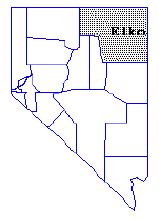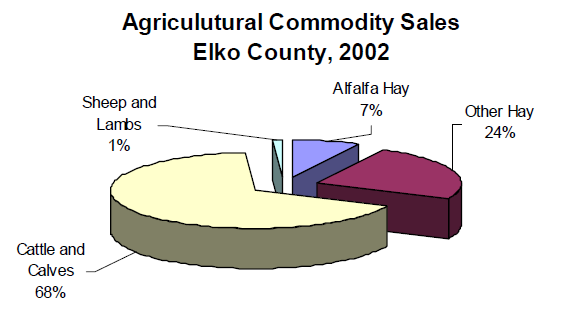Elko County was organized as a political subdivision of Nevada in 1869. The economy is based on traditional agriculture, mining, and casino/resort industries. This fact sheet is designed to provide an overview of important statistics relating to Elko County and its agricultural sector.

Elko ranks fourth of seventeen Nevada counties in terms of population, currently estimated at 50,620. The county encompasses 17,135 square miles or 10,990,186 acres of land of which 71.5 percent is administered by the federal government (Table 1). Elko county is home to four Native American reservations serving the Shoshone-Paiute Tribes of Duck Valley and the Elko, South Fork, and Wells Bands of the Te-Moak Tribe of Western Shoshone. A wide belt of “checkerboard” land resulting from the western railroad development crosses the central part of the county. These federally administered lands, however, contribute significantly to the agricultural sector, as they provide seasonal grazing for resident livestock herds. Privately owned land in farms comprises 26 percent of the land area in Elko County. The 1997 Census of Agriculture, the most recent census, reported that there were 402 farms and ranches within the county encompassing 2,855,472 acres for an average farm size of 7,103 acres.
Elko County typifies a true “Cow County” with vast plush grazing lands surrounded by rugged mountains. The county ranked fourth in the nation in number of beef cows tabulated in the 1997 Census of Agriculture. Agricultural production is focussed around the Ruby Mountains including Wells, Clover, Star, and Ruby Valleys, Lamoille, and Jiggs. Other areas of agricultural include the areas of North Fork, Mountain City, and Tuscarora along the Independence Mountain Range, the ranching communities of O’Neil and Jarbidge in the North Eastern portion of the county and the areas along the Humboldt River including Metropolis, Elko, Deeth, Haleck and Carlin.
Table 1. Elko County Demographics, Area, and Agricultural Data
| Category |
Amount |
| Population |
50,620 |
| Size |
10,990,186 acres or 17,135 square miles |
| Number of Farms and Ranches |
402 |
| Land in Farms |
2,855,472 acres |
| Average size |
7,103 acres |
| Cropland |
237,443 acres |
| Irrigated Farm Land |
205,189 acres |
Figure 1 and Table 2 provide an overview of Elko County’s agricultural sector for the 2002 production period.
Cattle and calves were the county’s largest contributor with $48,863,984 worth of commodity sales, 68 percent of the county total. Current statistics show the January 1, 2002 cattle and calf inventory for Elko County at 169,000.
Ranking second in commodity sales is other hay with a value of $17,604,600 or 24 percent of the total acres. This sector of hay includes native hay, grain hay, and improved grasses. Production covers approximately 122,000 acres at a rate of 1.3 tons per acre. The majority of this hay is used on farm for winter supplemental feeding in livestock operations.
Alfalfa hay, is Nevada’s leading crop but ranks third in terms of agricultural commodity production in Elko County. Alfalfa hay is produced on 18,000 acres in the county with an average per acre tonnage of 2.9. The 53,000 tons annually produced are used in livestock operations or sold to outside markets. During 2002 alfalfa hay recorded $5,376,600 or 7 percent of the county’s total agricultural sales.
The last major agricultural enterprise reported would be the sheep and lamb industry. Elko County is Nevada’s largest sheep and lamb producing county. This enterprise makes up 1% or $813,000 of agricultural sales. Current data report the January 1, 2002 inventory at 25,000 head.
Figure 1.

Data From Figure 1
Table 2. Sales by Commodity Elko County
| Hey Type |
Amount |
| Alfalfa Hay |
$5,376,600 |
| Other Hay |
$17,604,600 |
| Total Hay |
$22,981,200 |
| Livestock type |
Amount |
| Cattle and Calves |
$48,863,984 |
| Sheep and Lambs |
$813,000 |
| Total Livestock |
$49,676,984 |
| All Hay and Livestock |
$72,658,184 |
Information to compile this fact sheet was attained from the 2002-2003 Nevada Agricultural Statistics Service’s Annual Report and the 1997 Census of Agriculture. Data is collected in the Spring and published in the Fall following the production period. Thus the one year lag timeframe. These agencies appreciate the support of Elko County producers that provide survey information. Questions regarding statistics used in this fact sheet should be directed to the Authors.
Owens, M. and Riggs, W.
2003,
Economic Development 2002 Elko County Agricultural Statistics,
Extension | University of Nevada, Reno, FS-03-61


